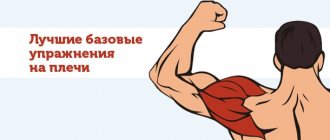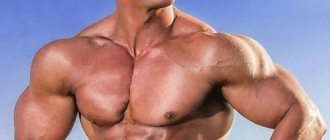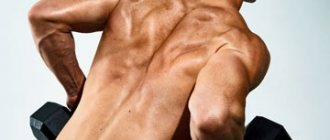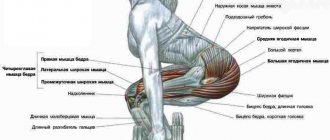Broad shoulders are a sign of strength and masculinity, everyone knows this. But not everyone knows how to do this. From our article you will learn what exercises make your shoulders truly royal.
In this article, you will read how to build broad shoulders step by step. Why do you need this? Stop! Don't you want to have broad, muscular shoulders? Don't you want to look strong? Don't you want to have a beautiful, balanced body, such that all women will go crazy about your wide and prominent shoulders? Building a proportionate deltoids and trapezius should be the goal of anyone who wants to create a complete physique. Want to? Then read on!
Video training for pumping up broad shoulders
It's time to learn how to create powerful and strong shoulders. The exercises and programs presented below will help you get the most out of every trip to the gym, regardless of the frequency of your workouts. Do not forget about the correct technique and do not use too much weight to avoid injury and be sure to warm up. Two ready-made programs if you are already in the gym and ready to train. Detailed modules for these videos can be found in this article.
For more experienced readers, we suggest that you familiarize yourself with a small theoretical part and move on to the “sweet” part.
Standing barbell press and seated dumbbell press
In terms of the intensity of work of the front and lateral deltas, the standing press has no equal. Use a grip slightly wider than shoulder width, hold the bar just below your chin, and press it without locking your elbows. Return to the starting position. This should be one smooth movement without long pauses at the top of the exercise. This should be one smooth movement without long pauses at the top of the exercise.
Seated dumbbell press
At the top of the exercise, keep your hands motionless so as not to injure the shoulder joint. An excellent alternative is the seated barbell press on a Smith machine. This machine allows you to use more weight by contracting the supporting muscles that will be used in the exercise.
Breedings
Here are some exercises for raising dumbbells and arms in a block. Include them in your training program if you want to effectively pump up your shoulders. To engage the lateral head of the deltoid, when doing dumbbell lateral raises (seated or standing), start with the dumbbells slightly in front of your hips and your elbows slightly bent. Raise your arms out to your sides to shoulder level. Hands are parallel to the floor, little fingers pointing up.
Technique tip. Point your thumb downwards while doing this without twisting. This isolates the lateral deltoid as much as possible, so use a light weight to perform the exercise correctly.
To raise your arms to the sides on a pulley, stand next to the machine and attach a D-shaped handle. Cross your arms in front of you, elbows slightly bent. Raise your arms out to your sides to shoulder level, they should be parallel to the floor, with your little fingers pointing up.
To change up the pace, try standing dumbbell lateral raises (one arm). Raise the dumbbell in the same way as when performing the exercise with both hands until your arm is parallel to the floor. In fact, it will go slightly higher than shoulder level compared to the usual version. This method activates more deltoid fibers and isolates one side, allowing you to use more weight and build wider shoulders faster.
To pump the posterior head of the deltoid muscle, you can perform dumbbell raises to the sides while sitting or dumbbell raises to the sides while standing. When bent over, your thighs should be parallel to the floor, as if you were doing a Romanian deadlift. Don't arch at the waist. Try not to move the dumbbells too far to the sides and back, as this will create additional stress on your back.
As a small change to better pump up the broad shoulders, namely the rear deltoid, try lateral raises on the lower block.
Vertical barbell row and vertical row on the block
To round out your deltoids, especially your side deltoids, try wide-grip vertical rows.
Using cables will help maintain constant tension in the muscles, especially during the squeeze at the top of the exercise for maximum contraction.
If the vertical row is uncomfortable for you, but you want to experience the benefits of this exercise, try doing the vertical row with dumbbells. Hold dumbbells in front of you at hip level and perform the exercise similar to a barbell upright row. The difference will be in the freedom of arm movement, which will reduce the load on the shoulder girdle.
Lifting the barbell and raising dumbbells in front of you
Front raises are often used as the final exercise in broad shoulder training for the anterior and lateral deltoids.
If you can't get to the gym or simply don't have access to weights, there's another option for performing front raises: with barbell plates. This is a really convenient replacement for exercises to pump up broad shoulders with a barbell or dumbbells. Choose a weight with which you can perform the required number of repetitions as if you were holding a handlebar. Hold the bottom of the plate so you can wiggle it a little as you lift it. Do the exercises by also lifting the barbell in front of you.
Shrugs with a barbell and shrugs with dumbbells
They will help you quickly build up broad shoulders. Grasp the barbell shoulder-width apart with an overhand grip and hold it at hip level. Do not pull your shoulders forward or backward, as this can lead to injury.
A great alternative to traditional behind-the-back barbell shrug movements. Stand in front of a Smith machine and grab a barbell with an overhand grip behind you at buttock level. Take a step forward so you can remove the barbell. Perform the exercise similar to the barbell shrug technique. The range of motion may be somewhat limited here, so be careful and ensure proper body positioning.
Some people find dumbbell shrugs more comfortable and functional. The fact is that you hold the barbell in front of you, it pulls you a little forward, and you lift the dumbbells to the sides, which helps maintain balance. Hold the dumbbells at your sides and lift your shoulders, contracting your trapezius muscles.
And finally, the long-awaited training program that will make your shoulders incredibly powerful.
Extension of the latissimus muscles
The back muscles, when viewed from behind, complement the broad shoulders and form a triangular back, creating a powerful torso. For their active growth, it is necessary to use the following exercises:
♦ Pull-up with a wide grip to the chest;
♦ Bent-over barbell row;
♦ Pull of the upper block behind the head;
♦ Pulldown of the upper block to the chest;
♦ Pulling the block to the belt;
♦ Bent-over row of 1 dumbbell to the waist.
Don't forget about the deadlift, but it is not recommended to do it in young adolescence or if you have a lower back injury.
Pump up your shoulders. Option #1
Standing barbell press
- 3 sets of 8-12 reps
- Body part: Shoulders Equipment: Barbell
Standing dumbbell lateral raises
- 3 sets of 8-12 reps
- Body part: Shoulders Equipment: Dumbbells
Two-hand dumbbell lateral raises
- 3 sets of 10-15 reps
- Body part: Shoulders Equipment: Dumbbells
Raising dumbbells in front of you
- 2 sets of 10-15 reps
- Body part: Shoulders Equipment: Dumbbells
Shrugs with a barbell
- 3 sets of 8-12 reps
- Body part: Trapeze Equipment: Barbell
Add to Calendar * Add to My Workouts * Print Workout
* — The service is in beta testing
Don't forget about post-workout recovery, for example, try massage for athletes.
Verified by NASA
NASA research has shown that the conditions under which you train do not matter for muscle growth. The muscles just need tension. It is this that stimulates their growth and increase in strength.
Kenneth Baldwin, a professor in the Department of Physiology and Biophysics at the University of California, supported by NASA, studied muscle growth in rats trained using different types of physical activity.
Through painless electrical stimulation, Baldwin stimulated the rats' muscles to contract isometrically (static contraction), isotonic (normal contraction), and eccentrically (negative contraction). The results forever closed the debate about the best way to train.
Baldwin stated, “We found that after 12 sessions of each type of training, the amount of muscle growth in each group was the same,” even with isometric exercises, which are not actual movements.
Pump up your shoulders. Option No. 2
Standing lateral raises with dumbbells
- 3 sets of 10-15 reps
- Body part: Shoulders Equipment: Dumbbells
Vertical barbell pull
- 3 sets of 10-15 reps
- Body part: Shoulders Equipment: Barbell
Bench press sitting behind the head
- 3 sets of 8-12 reps
- Body part: Shoulders Equipment: Barbell
One-arm dumbbell raise to the side (one arm)
- 2 sets of 10-15 reps
- Body part: Shoulders Equipment: Dumbbells
Attention: perform 10-15 repetitions with one hand, and then change to the next one
Standing dumbbell shrugs
- 3 sets of 8-12 reps
- Body part: Trapeze Equipment: Dumbbells
Add to Calendar * Add to My Workouts * Print Workout
* — The service is in beta testing
Muscles are forged in the kitchen, so make it a rule: prepare your things for training, think about lunch.
Enlargement of the skeleton in the upper part of the shoulder girdle
This rule applies to those who have not yet turned 20-22 years old; unfortunately, the skeleton cannot be expanded further, since it is considered already formed. If you still have such an opportunity, then you need to pay attention to the following exercises:
♦ Pullover with dumbbell;
♦ Dips for chest.
Perform these exercises twice a week with approximately equal periods of time between workouts, for example Tuesday and Friday.
Pump up your shoulders. Option #3
Two-hand dumbbell lateral raises
- 3 sets of 10-15 reps
- Body part: Shoulders Equipment: Dumbbells
Standing dumbbell lateral raises
- 3 sets of 10-15 reps
- Body part: Shoulders Equipment: Dumbbells
Dumbbell Incline Shoulder Press
- 3 sets of 8-12 reps
- Body part: Shoulders Equipment: Dumbbells
Raising arms to the sides on the lower block
- 3 sets of 10-15 reps
- Body part: Shoulders Equipment: Block
Shrugs on the Smith Machine
- 3 sets of 10-15 reps
- Body part: Trapezium Equipment: Exercise
Add to Calendar * Add to My Workouts * Print Workout
* — The service is in beta testing
Everything that doesn't kill us makes us stronger! Remember these words when the workout seems too difficult.
Dumbbell flyes
I consider standing dumbbell flyes to be the main exercise for deltoids . Yes, for the whole body this is an isolated exercise, but for the middle head of the deltas this is a basic exercise. The lateral head moves the arm away from the body, so why not train this function by simply holding dumbbells? Simple and most effective.
In order to perform technically correct dumbbell flyes while standing, you need to remember that the elbow joint at the top point of the movement should always remain above the hand. Movement occurs only in the shoulder joint, the arms move only in the plane of the body to the sides, the movement is determined by the humerus, not the hands. You must try to pull the projectile up as if with your elbows. You should not raise the humerus above the level of the deltas, this is fraught with injuries and the involvement of the trapezius muscles.
As a rule, in this exercise they do not use large weights, but try to take moderate weights for 10-12 or more repetitions. All movements are smooth, the arms should not be absolutely straight, they are allowed to bend at the elbows, but not to a right angle. To engage the middle deltoid as much as possible, it is recommended to lean forward slightly.
Pump up your shoulders. Option No. 4
Standing barbell press
- 5 sets of 5-8 reps
- Body part: Shoulders Equipment: Barbell
Vertical barbell pull
- 5 sets of 5-8 reps
- Body part: Shoulders Equipment: Barbell
Shrugs with a barbell
- 5 sets of 5-8 reps
- Body part: Trapeze Equipment: Barbell
Add to Calendar * Add to My Workouts * Print Workout
* — The service is in beta testing
Now you know what exercises will help you build broad shoulders. Follow these recommendations step by step, and the result will not be long in coming. Be confident in your abilities and move unwaveringly towards your goal. For impressive results, include sports supplements in your regimen.
Forecasts for increasing shoulder width: when will the result be?
I’ll say right away that if you photoshopped your shoulders like Hercules’, but in reality you have them like a frail sparrow, but you have a date coming up, then the girl will be twice as unsatisfied.
This delicate and thorough process can take more than one year. You will have to dedicate yourself to this, but believe me, it will be the best investment of your time. As they say, broad shoulders are the head of everything. If you have broad shoulders, you will have a good job, a beautiful wife, and smart kids.
The harder you train and eat, the faster the results will be. If you train well, but at the same time you feed only on solar energy, then forget about broad shoulders once and for all. I told you how to eat to gain weight here.
Remember the following rules when performing shoulder exercises:
- The most important factor in muscle growth is tension, regardless of the movement: isometric, isotonic or eccentric.
- The shoulders are a complex system of bones, tendons and muscles that can easily be damaged if the exercise technique is not followed correctly.
- The safest way to quickly pump up your shoulders at home is through slow and focused movements following the technique.
- In order to get large and powerful deltoids, no additional equipment is needed.
Vertical push-ups
In the starting position, take a classic support with your hands. Move your feet close to the wall and slowly move them to the top point along the plane. As a result, the body should be in a vertical position with emphasis on the hands. Push up, bending your elbows at right angles. Avoid sudden movements and complete exhaustion. Otherwise, the risk of injury and falling on your head increases.
Weight shift push-ups
Push-ups are traditionally used to train the pectoral muscles. However, there are certain variations of the exercise that place significant stress on the deltoid muscles of the shoulder girdle.
How to make your shoulders wider with push-ups? Stand in a lying position with your hands wider than shoulder-width apart. Bring your feet together. Keep your back straight. Raise one leg up and lock it in a static position. Perform a series of push-ups until you run out of strength. Then rest for a few minutes, change legs and repeat the exercise. Adopting this position will shift the main load towards the deltoid muscles of the shoulder girdle.











